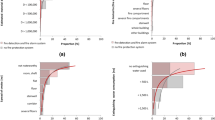Abstract
Fire protection engineers and preservation architects have long recognized the difficulty in applying building and fire codes to historic buildings. Small, older buildings of significant historic value need an efficient approach to performance-based evaluation. One technique that has gained acceptance is fire risk indexing. The Historic Fire Risk Index described in this paper uses a linear additive model of multiple attribute evaluation to produce a measure of relative fire risk. Weights are established to indicate the importance or significance of fire risk parameters. Then, for each specific historic structure, parameter grades, i.e., the amount or degree that a parameter is present, are determined from information collected in a detailed site survey. Fire risk is evaluated by the scalar product of the parameter weights and grades, producing a single numerical value representing the level of fire safety provided in the building. This is a more rational and more transparent method than the risk indexing systems currently published in model codes and standards.
Similar content being viewed by others
References
M.E. Kaplan, “The Regulation of Existing and Historic Buildings,” unpublished thesis, Troy, NY: Rensselaer Polytechnic Institute, 1996.
ISO/TC 92/SC 4, “Fire Safety Engineering—The Application of Fire Performance Concepts to Design Objectives,” Committee Draft ISO CD 13387, International Organization for Standards, 1997, p. 5.
J.M. Watts, Jr., “Fire Risk Assessment in Cultural Resource Facilities,” in Fire Risk and Hazard Assessment Symposium Proceedings, Quincy, MA: National Fire Protection Research Foundation, 1996, pp. 508–522.
J.M. Watts, Jr., and M.E. Kaplan, “Performance-Based Approaches to Protecting our Heritage,” in Proceedings of the International Conference on Performance-Based Codes and Fire Safety Design Methods, Ottawa, Canada, September 24- 26, 1996, Boston: Society of Fire Protection Engineers, 1997.
A.F. Dean, “Analytic System for the Measurement of Relative Fire Hazard,” Chicago: Western Actuarial Bureau, 1902.
J.M. Watts, Jr., “Fire Risk Indexing,” in P.J. DiNenno et al. (eds.), SFPE Handbook of Fire Protection Engineering, 3rd ed., Quincy MA: National Fire Protection Association, 2002, sec. 5, chap. 10.
NFPA 101A, Guide on Alternative Approaches to Life Safety, Quincy, MA: National Fire Protection Association, 1998.
NFPA 101, Life Safety Code, Quincy MA: National Fire Protection Association, 1997.
The BOCA National Building Code/1996, Country Club Hills, IL: Building Officials and Code Administrators International, 1996.
Wisconsin Administrative Code, chapter ILHR 70, “Historic Buildings,” Madison: Department of Industry, Labor, and Human Relations, 1995.
J.M. Watts, Jr., “Fire Risk Assessment Using Multiattribute Evaluation,” in Fire Safety Science, Proceedings of the Fifth International Symposium, International Association for Fire Safety Science, 1997, pp. 679–690.
R.M. Dawes, “The Robust Beauty of Improper Linear Models in Decision Making,” American Psychologist, vol. 34, no. 7, 1979, pp. 571–582.
“Fire Safety Evaluation System for Business Occupancies,” in NFPA 101A, Guide on Alternative Approaches to Life Safety, Quincy, MA: National Fire Protection Association, 1998, Chap. 7.
“Compliance Alternatives,” in The BOCA National Building Code/1996, Country Club Hills, IL: Building Of.cialsand Code AdministratorsInternational, 1996, Section 3408.
J.M. Watts, Jr., “Fire Risk Evaluation in the Codes: A Comparative Analysis,” in Proceedings of the 2nd International Conference on Fire Research and Engineering, Gaithersburg, MD, 1997, pp. 226–237.
J.M. Watts, Jr., “Analysis of the NFPA Fire Safety Evaluation System for Business Occupancies,” Fire Technology, vol. 33, no. 3, 1997.
R.L. Keeny, and H. Raiffa, Decisions with Multiple Objectives, New York: John Wiley, 1976.
J.M. Watts, Jr., E.K. Budnick, and B.D. Kushler, “Using Decision Tables to Quantify Fire Risk Parameters,” in Proceedings of the International Conference on Fire Research and Engineering, Boston: Society of Fire Protection Engineers, 1995, pp. 241–246.
L.L. Parks, B.D. Kushler, M.J. Serapiglia, L.A. McKenna, Jr., E.K. Budnick, and J.M. Watts, Jr., “Fire Risk Assessment for Telecommunications Central Offices,” Fire Technology, vol. 34, no. 2, 1998, pp. 156–176.
E.W. Marchant, “Fire Safety Evaluation (Points) Scheme for Patient Areas Within Hospitals,” Department of Fire Safety Engineering, University of Edinburgh, 1982.
M.E. Kaplan, and J.M. Watts, Jr., “Development of a Prototypical Historic Fire Risk Index to Evaluate Fire Safety in Historic Buildings,” APT Bulletin, vol. 30, nos. 2- 3, 1999, pp. 49–54.
Author information
Authors and Affiliations
Rights and permissions
About this article
Cite this article
Watts, J.M., Kaplan, M.E. Fire Risk Index for Historic Buildings. Fire Technology 37, 167–180 (2001). https://doi.org/10.1023/A:1011649802894
Issue Date:
DOI: https://doi.org/10.1023/A:1011649802894



